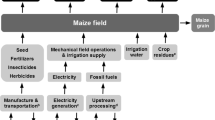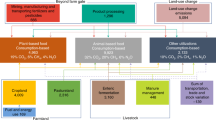Abstract
This meta-study quantitatively and qualitatively compares 21 published life cycle assessment (LCA)-type studies for energy consumption and greenhouse gas (GHG) emissions of maize production in the USA. Differences between the methodologies and numerical results obtained are described. Nonrenewable energy consumption in maize production (from cradle-to-farm gate) ranges from 1.44 to 3.50 MJ/kg of maize, and GHG emissions associated with maize production range from −27 to 436 g CO2 equivalent/kg of maize. Large variations between studies exist within the input data for lime application, fuels purchased, and life cycle inventory data for fertilizer and agrochemical production. Although most studies use similar methodological approaches, major differences between studies include the following: (1) impacts associated with human labor and farm machinery production, (2) changes in carbon dioxide emissions resulting from soil organic carbon levels, and (3) indirect N2O emissions.

Similar content being viewed by others
References
United States Department of Agriculture (2012) U.S. & All States Data – Crops. http://www.nass.usda.gov/. Accessed 9 September 2013
National Corn Growers Association (2013) 2013 World of corn. http://www.ncga.com/file/583. Accessed 9 September 2013
Field to Market (2012) Environmental and socioeconomic indicators for measuring outcomes of on-farm agricultural production in the United States; Summary Report: Second Report. www.fieldtomarket.org. Accessed 9 September 2013
Alexander RB, Smith RA, Schwarz GE, Boyer EW, Nolan JV, Brakebill JW (2008) Differences in phosphorus and nitrogen delivery to the Gulf of Mexico from the Mississippi River Basin. Environ Sci Technol 42:822–830
Argonne National Laboratory (2012) Greenhouse gases, regulated emissions, and energy use in transportation (GREET) computer model. http://greet.es.anl.gov/. Accessed 9 September 2013
International Organization for Standardization (2006) ISO 14040: environmental management—life cycle assessment—principles and framework
Wang M, Saricks C, Wu M (1999) Fuel ethanol produced from Midwest US corn: help or hindrance to the vision of Kyoto? J Air Waste Manag Assoc 49:756–772
West TO, Marland G (2002) A synthesis of carbon sequestration, carbon emissions, and net carbon flux in agriculture: comparing tillage practices in the United States. Agr Ecosyst Environ 91:217–232
Kim S, Dale BE (2004) Cumulative energy and global warming impact associated with producing biomass for biobased industrial products. J Ind Ecol 7:147–162
Kim S, Dale BE (2005) Environmental aspects of ethanol derived from no-tilled corn grain: nonrenewable energy consumption and greenhouse gas emissions. Biomass Bioenerg 28:475–489
Hill J, Nelson E, Tilman D, Polasky S, Tiffany D (2006) Environmental, economic, and energetic costs and benefits of biodiesel and ethanol biofuels. Proc Natl Acad Sci U S A 103:11206–11210
Landis AE, Miller SA, Theis T (2007) Life cycle of the corn-soybean agroecosystem for biobased production. Environ Sci Technol 4:1457–1464
Wu M, Wang M, Liu J, Huo J (2008) Assessment of potential life-cycle energy and greenhouse gas emission effects from using corn-based butanol as a transportation fuel. Biotechnol Prog 24:1204–1214
Kim S, Dale BE (2009) Regional variations in greenhouse gas emissions of biobased products in the United States-maize-based ethanol and soybean oil. Int J LCA 14:540–546
Kim S, Dale BE, Jenkins R (2009) Life cycle assessment of corn and corn stover in the United States. Int J LCA 14:160–174
Pimentel D, Marklein A, Megan AT, Karpoff MN, Paul GS, McCormack R, Kyriazis J, Krueger T (2009) Food versus biofuels: environmental and economic costs. Hum Ecol 37:1–12
Liska AJ, Yang HS, Bremer VR, Klopfenstein TJ, Walters DT (2009) Improvements in life cycle energy efficiency and greenhouse gas emissions of corn-ethanol. J Ind Ecol 13:58–74
Urban RA, Bakshi BR (2009) 1,3-Propanediol from fossils versus biomass: a life cycle evaluation of emissions and ecological resources. Ind Eng Chem Res 48:8068–8082
Clarens AF, Resurreccion EP, White MA, Colosi LM (2010) Environmental life cycle comparison of algae to other bioenergy feedstocks. Environ Sci Technol 44:1813–1819
Grassini P, Cassman KG (2012) High-yield maize with large net energy yield and small global warming intensity. Proc Natl Acad Sci U S A 109:1074–1079
Adom F, Maes A, Workman C, Clayton-Nierderman Z, Thoma G, Shonnard D (2012) Regional carbon footprint analysis of dairy feeds for milk production in the USA. Int J LCA 17:520–534
Camargo GGT, Ryan MR, Richard TL (2013) Energy use and greenhouse gas emissions from crop production using the farm energy analysis tool. BioSci 63:263–273
Shapouri H, Duffield JA, Graboski MS (1995) Estimating the net energy balance of corn ethanol. AER-721, U.S. Department of Agriculture, Economic Research Service, Washington, DC. http://www.ers.usda.gov/publications/aer721/. Accessed 9 September 2013
Shapouri H, Duffield JA, Wang M (2002) The energy balance of corn ethanol: an update. AER-814, U.S. Department of Agriculture, Economic Research Service, Washington, DC. http://www.transportation.anl.gov/pdfs/AF/265.pdf. Accessed 9 September 2013
Shapouri H, McAloon A (2005) The 2001 net energy balance of corn-ethanol. U.S. Department of Agriculture, Washington, DC. http://www.google.com/url?sa=t&rct=j&q=&esrc=s&frm=1&source=web&cd=3&ved=0CDcQFjAC&url=http%3A%2F%2Fwww.deq.mt.gov%2FEnergy%2Fbioenergy%2Fjune2004ethanolconference%2F03ConwayRoger.pdf&ei=rr0tUvCvCOSVygHsi4CgDA&usg=AFQjCNEUZeWg870Fe9eGcC5JBMAd96rtxw&sig2=8adMCyOrtuti_4swrZLDGQ&bvm=bv.51773540,d.aWc. Accessed 9 September 2013
Shapouri H, Paul W, Nefstead W, Schwartz R, Noe S, Conway R (2010) 2008 energy balance for the corn-ethanol industry. AER-846, U.S. Department of Agriculture, Economic Research Service, Washington, DC. http://www.usda.gov/oce/reports/energy/2008Ethanol_June_final.pdf. Accessed 9 September 2013
Economic Research Service (2005) Commodity costs and returns. U.S. Department of Agriculture, Economic Research Service, Washington, DC. No longer available
Intergovernmental Panel on Climate Change (2006) 2006 IPCC guidelines for national greenhouse gas inventories. http://www.ipcc-nggip.iges.or.jp/public/2006gl/index.html. Accessed 9 September 2013
National Renewable Energy Laboratory (2012) U.S. Life cycle inventory database. http://www.nrel.gov/lci/. Accessed 9 September 2013
Jungbluth N, Chudacoff M, Dauriat A et al (2007) Life cycle inventories of bioenergy. Final report ecoinvent data v2.0 No. 17
Wang M, Han J, Dunn JD, Cai H, Elgowainy A (2012) Well-to-wheels energy use and greenhouse gas emissions of ethanol from corn, sugarcane and cellulosic biomass for US use. Environ Res Lett 7:045905. doi:10.1088/1748-9326/7/4/045905
Frischknecht R, Althaus H, Bauer C, Doka G et al (2007) The environmental relevance of capital goods in life cycle assessments of products and services. Int J LCA 12:7–17
Economic Research Service (2010) Farm and ranch irrigation survey 2008. U.S. Department of Agriculture, Washington, DC. http://www.agcensus.usda.gov/Publications/2007/Online_Highlights/. Accessed 9 September 2013
United States Environmental Protection Agency (2012) U.S. greenhouse gas inventory report: Inventory of U.S. greenhouse gas emissions and sinks: 1990-2010. United States Environmental Protection Agency, Washington, DC. http://www.epa.gov/climatechange/emissions/usinventoryreport.html. Accessed 9 September 2013
West TO, McBride AC (2005) The contribution of agricultural lime to carbon dioxide emissions in the United States: dissolution, transport, and net emissions. Agr Ecosyst Environ 108:145–154
Follett RF, Vogel KP, Varvel GE, Mitchell RB, Kimble J (2012) Soil carbon sequestration by switchgrass and no-till maize grown for bioenergy. Bioenerg Res 5:866–875
Hauschild MZ, Wenzel H (1998) Environmental assessment of products: volume 2: scientific background. Chapman & Hall, London
Acknowledgments
This work was funded by National Corn Growers Association and DOE Great Lakes Bioenergy Research Center (DOE BER Office of Science DE-FC02-07ER64494 and DOE OBP Office of Energy Efficiency and Renewable Energy DE-AC05-76RL01830). The authors wish to thank the two anonymous reviewers for their constructive comments and suggestions.
Author information
Authors and Affiliations
Corresponding author
Rights and permissions
About this article
Cite this article
Kim, S., Dale, B.E. & Keck, P. Energy Requirements and Greenhouse Gas Emissions of Maize Production in the USA. Bioenerg. Res. 7, 753–764 (2014). https://doi.org/10.1007/s12155-013-9399-z
Published:
Issue Date:
DOI: https://doi.org/10.1007/s12155-013-9399-z




